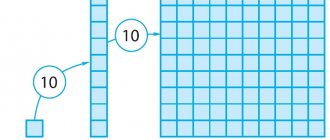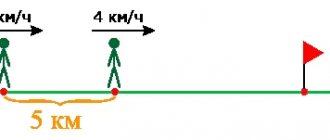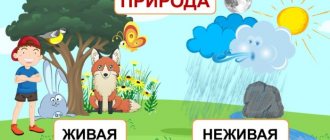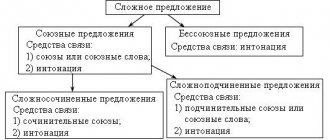Math lesson in 4th grade “Table of area units”
~~Mathematics lesson in 4th grade
Lesson Topic: Table of Area Units
Objectives: general educational: • learn to convert area units from small to large, from large to small • improve oral and written computing skills and ability to solve problems on the topic developing: • develop thinking and elements of creative activity • develop the ability to operate with geometric images, formulas • develop cognitive activity educational: • education of moral and emotional qualities, admiration for the beautiful and the desire to preserve this beauty • education of love for the native land, the desire for knowledge
Objectives: systematize knowledge about the relationships between the studied area units, develop the ability to convert area units.
Equipment: interactive whiteboard; computer; multimedia projector; presentation made in PowerPoint; multi-level cards for independent work; reference diagrams for converting area units.
During the classes:
I. Psychological attitude. (1 min) - Today in the lesson we will continue to work with various units of area. Ahead of us lies an exciting mathematical walk through the Caucasian Biosphere Reserve.
II. Mathematical warm-up. (5-7 mn) 1) (Slide 2) How to measure area? There is no easier task! To find out the area we need to know the quantities! — In what units are the areas of figures measured? - What formula can you use to find the area of a rectangle? — How to find the area of a square?
2) (Slide 3) Exercise in finding the area of a rectangle and a square - Find the area of a rectangle with sides of 6 cm and 4 cm - What is the area of a square with a side of 7 dm?
3) (Slide 4) Fill out the table - How to find the side of a rectangle if its area and other side are known?
S 50 cm² 48 km² 120 mm² 60 dm² a 6 km 6 dm b 25 cm 2 cm
4) (Slide 5) (Logic problem) - How to find the area of a polygon? (students’ opinions are listened to and a conclusion is drawn. If there is difficulty, the teacher directs the students’ activities)
Look carefully at the drawing. Let's divide it into two rectangles. -Try to find the area of each of them. -We don’t know the length of the second figure obtained? -How to find the length? (From the length of a side of 9 cm, subtract sides of 2 cm and 2 cm, we get the length of the second figure - 5 cm.) - What do we do next? (Find the area of each resulting figure) -How can we now find out the area of each figure? (The main figure consists of two rectangles, the areas of which are already known. Let’s add their areas and find the area of the main figure)
5) (Slide 6) Area of a triangle - Find the area of a rectangle with sides 12 dm and 6 dm.
(Animation effects are used, as a result of which the rectangle is divided into two triangles)
- What do you think is the area of each of the resulting triangles? (36 dm²) - What formula can be made to find the area of triangles? (SΔ=(a•b): 2)
III. Preparation for active and conscious assimilation of new material. (2-3 min) 1) (Slide 7) Match
square with side 1 cm square with side 1 m square with side 1000 m square with side 10 cm square with side 100 m square with side 1 mm square with side 10 m (after the children answer, the teacher displays the correct answer with a mouse click)
2) (Slides 8-9) Arrange the area units in ascending order - How many times is the next area unit larger than the previous one? (100 times)
IV. Assimilation of new knowledge. Compiling a table of area units. (5-7 min)
(Slide 10) Problematic question - How many hectares are there in 5 square kilometers? (500ha) - How many square meters are in 9 square kilometers? (Probable answers are listened to) - Is it easy for you to answer this question? — Today in class we will develop an algorithm that will help you easily solve this issue
(Slides 11-16) - Let's combine the area units into a single table. Let's start with the larger units. 1 km²= … ha = … a = … m²
From square kilometers to hectares there is 1 transition, and we know that the next unit of area is 100 times larger than the previous one, so we write: 1 km²= 100 hectares From square kilometers to ares 2 transitions, 100•100 10000, therefore: 1 km²= 10000 a From square kilometers to square meters 3 transitions, 100•100•100=1000000, therefore: 1 km²= 1000000 m²
(Customized animation allows you to accompany the teacher’s explanation or student responses with appropriate actions) By analogy, the compilation of a table of area units continues.
(Slide 17) (Return to the problematic question) - How many square meters are there in 9 square kilometers? (9000000m²) — How did you find out? How many transitions are there from sq. km to sq. m? How many times did you multiply by 100? - Let's conclude how to convert large units of area into smaller ones? (You need to multiply this value by 100 as many times as there are transitions to the required units) (After clicking on it, a reference diagram appears on the screen: ? • 100, suggesting that for each transition from large units to small ones you need to multiply by 100) - How many square meters .m in 400,000 sq.cm? How did you find out? — What happens to the number when moving from small units of area to large ones? — How many times did you divide by 100? Why? — Conclude how to express small units of area in larger ones? (You need to divide this value by 100 as many times as there are transitions to the required units) Display the diagram: ? : 100
V. Physical exercise. (2 min) VI. Practical work on the application of the derived algorithm.
Mathematical simulator “Walk through the Caucasian Biosphere Reserve” - I suggest you take a walk through the Caucasus Biosphere Reserve and get acquainted with some of its attractions. (Slides 18-23) 1. Translation of area units (based on the visual “chain of area units” displayed at the top of each slide) (6-7 min) • The Caucasus Biosphere Reserve is one of the oldest reserves in Russia. Its area is 280,335 hectares. Express the area in ar. • The largest lake in the reserve is Lake Silence, with a water surface area of 200,000 square meters. m Express the area in hectares. • In the Khostinsky district of Sochi, the subtropical Khostinsky department of the Caucasus Nature Reserve is located - a world-famous yew-boxwood grove with an area of 302 hectares. Express the area in square meters. • The picnic area allowed for visiting on the territory of the Yew-boxwood grove in the area of the Devil’s Gate canyon covers an area of 1200 m² Which units of area are expressed correctly? • The largest glacier in the Caucasus Nature Reserve and in the Krasnodar Territory is considered to be the Pseashkho glacier with an area of 180 hectares. Express the area in square meters. (Translation of area units is carried out in writing in notebooks with comments and explanations. The teacher, as work progresses, introduces schoolchildren to the sights of the Caucasian Biosphere Reserve)
2. Independent work using cards (3 levels of difficulty) (5 min) (Students receive multi-level cards) - In independent work, you must complete the first task. The second task is additional for those who quickly complete the work. You have reference diagrams on your desks that you can use to do your work. (The diagrams are similar to slide 17) High level:
Average level:
Easy level:
3. Checking independent work. Self-test and self-assessment. (3-4 min) (Slides 24-27) Duplicate independent work tasks. A frontal check of the work performed is combined with a self-check. For each slide, the teacher continues to introduce students to the sights of the reserve.
4. Work according to the textbook. (8-10 min) 1) page 44 No. 205. Compare units of length and area. The work is done in pairs. Students can confer with their deskmate when completing a task and conduct a mutual check. 2) page 44 No. 207 (1 column) Solving examples on the order of actions. Three students work at the board, the rest in notebooks according to the options. A post-execution check is carried out.
VII. Information about homework, instructions on how to complete it. (1-2 min) Optional task: 1. Page. 44 No. 206, No. 207 (2, 3 columns) 2. Using materials from additional sources, compose 2 problems to find the area in different units of measurement.
VII. Lesson summary. Performance assessment. (1-2 min) - Which task in the lesson did you like the most? — What was the most difficult? — In what profession can the knowledge acquired on this topic be useful? — What action must be performed when converting area units to larger units of measurement? To smaller ones?
Download material
so UNT / Lesson developments / Lessons in Mathematics
Notes for the mathematics lesson “Relationship between units of length and units of area” 4th grade
02/06/2015 3976 734 Aksenova Ksenia Aleksandrovna Goal: to consolidate knowledge of the ratio of units of length. Objectives: 1. Improve skills in solving problems to find the perimeter. 2. Develop logical thinking, attention, activity, independence. 3. Cultivate friendliness and attentive attitude towards each other. Equipment: textbook, presentation, cards for working in pairs, cards with signs (greater than, less than, equal to), cards with multi-level tasks, cards with numbers, chips.
Lesson progress: 1. Organizational moment. — Guys, for today’s lesson I have prepared a surprise for you. What kind of surprise you will find out if you guess which fairy tale these words come from: Fly, fly petal Through the west to the east Through the north, through the south Come back, having made a circle As soon as you touch the ground Be as I ordered... (Flower - seven-flowered) - Well done guys! -Do you remember who wrote this fairy tale? (V. Kataev) - Now listen to my fairy tale. In the mathematical kingdom, in the arithmetic state, in the village of “Velichina” there lived a girl. The teacher asked her to prepare assignments for the lesson...
Queen Mathematics gave the girl a flower - a seven-flowered one. Today he will help us teach a lesson. Let's help the girl too. After all, we must grow up to be kind, we must help each other. -Ready? Guys, you will work, and I will give you chips for your answers. At the end of the lesson, we will count who earned how many chips. 2. Oral counting. Slide 1. This red petal begins our lesson. We will conduct mental calculations and break all records. Slide 2. On the screen there are numbers in two rows: 70 cm, 97 cm2, 7050, 43000 m, 4 m2, 700 mm, 600 dm, 25 m2, 43 km, 40000 cm2, 60 m, 2500 dm2, 78 m, 9700 mm2 . -Read the numbers. -Which number is extra? (7050, because all other numbers are named) -What task could you suggest? (Divide the numbers into 2 groups: units of area and units of length) Make up equalities from these numbers. (Children make equalities) 70 cm = 700 mm 97 cm2 = 9700 mm2 43000 m = 43 km 4 m2 = 4000 cm2 600 dm = 60 m 25 m2 = 2500 dm2 - What number is left without a pair? (78m) - In order not to offend this number, let's find a pair for it. 78 m = 780 dm = 7800 cm = 78000 mm. - Well done!
3.Communication of the topic and objectives of the lesson. — Guys, what do you think is the topic of our lesson? (Ratio of units of length and units of area). - Right. Today we will continue to work with quantities. We will consolidate knowledge about measures of length and apply our knowledge in practice. 4. Updating of basic knowledge. Work at the board. Slide 3. Orange petal Continuing our lesson On the board we will solve without mistakes. - Let's repeat the table of length units: 1km = 1000m 1m = 10dm 1dm = 10cm 1cm = 10mm 1m = 100cm = 1000mm - Open your notebooks, write down today's date, class work and write down the task: Express in mm. Writing on the board made by the teacher: 100cm 5mm= …mm 37cm 8mm= …mm 207cm 3mm =…mm 575cm= …mm 27dm = …mm 3dm 4cm = …mm (children come to the board, talk and explain) Slides 4, 5. Suddenly our yellow petal flies to the east Returns to us from the east Work continues. Comparison of quantities. -Guys, on your desks are cards with the signs >, <, =. Assignment on a magnetic board. 730m...73km 83mm...8cm 35m...350dm 480cm...49dm 540dm...53m 26km...26000m (Children show signs. One student works at the board.) 5. Physical exercise. Slide 6. The middle of the flower is unknown yet. Here we tear it off. Let’s relax and play. One, two, three, four, five, We all know how to count One! Get up, pull yourself up Two! Bend over, straighten up Three! Clap your hands 3 times Head 3 nods 4 hands wider 5 hands wave 6 - sit quietly at your desk.
6. Work in pairs. Slide 7. The blue color is very pleasant. The petal is neat. We’ll tear it off together. We’ll sort out everything that needs to be done. Addition and subtraction of units of length. Each student has a card with a task on their desk. Children decide, exchange cards, check, and grade with a pencil. Peer review. -Now check your answers with the answers of the flower - seven flowers. Slide 8. 7. Working with the textbook. Slide 9. Blue flower Delicate petal Now we will tear you off And read what is written. Slide 10. Task. - Read the problem. Let's remember how to find the perimeter of a rectangle. (Children remember the rules for finding the perimeter, then solve the problem in different ways.) 8. Independent work. Slide 11. We will tear off the green color. We will not bear the surprise. This is a new concern. Independent work. Working on cards with multi-level tasks. Slide 12. Blue color - easy level. Green color – average level. Red color is a difficult level. 9. Lesson summary. Slide 13, 14. Purple flower Interesting petal Here we will tear it off and sum it up. - Guys, what can you do with quantities? -What did you do in class? -Which task did you like the most? So the fairy tale ends. The good sorceress Mathematics saved the girl, and the little flower of seven colors helped you consolidate your knowledge. - Now let's count how many chips each of you received. (Grading). — Write down your homework. -Thank you guys for the lesson. As a souvenir, I want to give you a “seven-flowered flower.” Let it help you in your studies.
See the downloadable file for the full text of the material.
The page contains only a fragment of the material.



